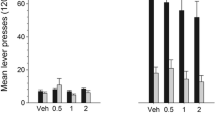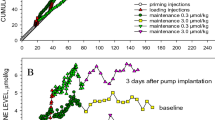Abstract
Rationale and objectives
Prolonged access to cocaine self-administration (long access or LgA) produces an escalation in drug intake not observed with limited access to the drug (short access or ShA). The present study tested the hypothesis that escalating use of cocaine is associated with chronic alterations in dopamine neurotransmission.
Methods
After escalation of cocaine self-administration, ShA and LgA rats were challenged with different subcutaneous doses of cis-flupenthixol (10–270 µg/kg), a highly selective dopamine receptor antagonist.
Results
In both groups, increasing doses of cis-flupenthixol first produced an increase in the number of cocaine injections and then a dramatic suppression of behavior. This biphasic dose–effect function—which replicates previous findings from this laboratory—was shifted to the left in LgA rats relative to ShA rats, thereby decreasing the threshold dose at which behavior was completely suppressed.
Conclusions
These data support the hypothesis that alterations in dopamine neurotransmission contribute to escalation of cocaine self-administration.

Similar content being viewed by others
References
Ahmed SH, Koob GF (1997) Cocaine- but not food-seeking behavior is reinstated by stress after extinction. Psychopharmacology 132:289–295
Ahmed SH, Koob GF (1998) Transition from moderate to excessive drug intake: change in hedonic set point. Science 282:298–300
Ahmed SH, Koob GF (1999) Long-lasting increase in the set point for cocaine self-administration after escalation in rats. Psychopharmacology 146:303–312
Ahmed SH, Walker JR, Koob GF (2000) Persistent increase in the motivation to take heroin in rats with a history of drug escalation. Neuropsychopharmacology 22:413–421
Ahmed SH, Kenny PJ, Koob GF, Markou A (2002) Neurobiological evidence for hedonic allostasis associated with escalating cocaine use. Nat Neurosci 5:625–626
Ahmed SH, Lin D, Koob GF, Parsons LH (2003) Escalation of cocaine self-administration does not depend on altered cocaine-induced nucleus accumbens dopamine levels. J Neurochem 86:102–113
Beninger RJ, Herz RS (1986) Pimozide blocks establishment but not expression of cocaine-produced environment-specific conditioning. Life Sci 38:1425–1431
Bergman J, Kamien JB, Spealman RD (1990) Antagonism of cocaine self-administration by selective dopamine D1 and D2 antagonists. Behav Pharmacol 1:355–363
Caine SB, Koob GF (1994) Effects of dopamine D-1 and D-2 antagonists on cocaine self-administration under different schedules of reinforcement in the rat. J Pharmacol Exp Ther 270:209–218
Caine SB, Heinrichs SC, Coffin VL, Koob GF (1995) Effects of the dopamine D1 antagonist SCH 23390 microinjected into the accumbens, amygdala or striatum on cocaine self-administration in the rat. Brain Res 692:47–56
Epping-Jordan MP, Markou A, Koob GF (1998) The dopamine D-1 receptor antagonist SCH 23390 injected into the dorsolateral bed nucleus of the stria terminalis decreased cocaine reinforcement in the rat. Brain Res 784:105–115
Ettenberg A, Pettit HO, Bloom FE, Koob GF (1982) Heroin and cocaine intravenous self-administration in rats: mediation by separate neural systems. Psychopharmacology 78:204–209
Gawin FH (1991) Cocaine addiction: psychology and neurophysiology. Science 251:1580–1586
Graziella de Montis M, Co C, Dworkin SI, Smith JE (1998) Modifications of dopamine D1 receptor complex in rats self-administering cocaine. Eur J Pharmacol 362:9–15
Henry DJ, White FJ (1991) Repeated cocaine administration causes persistent enhancement of D1 dopamine receptor sensitivity within the rat nucleus accumbens. J Pharmacol Exp Ther 258:882–890
Henry DJ, White FJ (1995) The persistence of behavioral sensitization to cocaine parallels enhanced inhibition of nucleus accumbens neurons. J Neurosci 15:6287–6299
Koob GF, Le HT, Creese I (1987) The D-1 dopamine receptor antagonist SCH 23390 increases cocaine self-administration in the rat. Neurosci Lett 79:315–320
Koob GF, Parsons LH, Caine SB, Weiss F, Sokoloff P, Schwartz JC (1996) Dopamine receptor subtype profiles in cocaine reward. In: Beninger RJ, Palomo T, Archer T (eds) Dopamine disease states. Editorial CYM, Madrid, pp 433–443
Koob GF, Sanna PP, Bloom FE (1998) Neuroscience of addiction. Neuron 21:467–476
Maggos CE, Tsukada H, Kakiuchi T, Nishiyama S, Myers JE, Kreuter J, Schlussman SD, Unterwald EM, Ho A, Kreek MJ (1998) Sustained withdrawal allows normalization of in vivo [11C]N-methylspiperone dopamine D2 receptor binding after chronic binge cocaine: a positron emission tomography study in rats. Neuropsychopharmacology 19:146–153
Moore RJ, Vinsant SL, Nader MA, Porrino LJ, Friedman DP (1998a) Effect of cocaine self-administration on dopamine D2 receptors in rhesus monkeys. Synapse 30:88–96
Moore RJ, Vinsant SL, Nader MA, Porrino LJ, Friedman DP (1998b) Effect of cocaine self-administration on striatal dopamine D1 receptors in rhesus monkeys. Synapse 28:1–9
Morency MA, Beninger RJ (1986) Dopaminergic substrates of cocaine-induced place conditioning. Brain Res 399:33–41
Nader MA, Daunais JB, Moore T, Nader SH, Moore RJ, Smith HR, Friedman DP, Porrino LJ (2002) Effects of cocaine self-administration on striatal dopamine systems in rhesus monkeys: initial and chronic exposure. Neuropsychopharmacology 27:35–46
Tsukada H, Kreuter J, Maggos CE, Unterwald EM, Kakiuchi T, Nishiyama S, Futatsubashi M, Kreek MJ (1996) Effects of binge pattern cocaine administration on dopamine D1 and D2 receptors in the rat brain: an in vivo study using positron emission tomography. J Neurosci 16:7670–7677
Unterwald EM, Fillmore J, Kreek MJ (1996) Chronic repeated cocaine administration increases dopamine D1 receptor-mediated signal transduction. Eur J Pharmacol 318:31–35
Vanderschuren LJ, Kalivas PW (2000) Alterations in dopaminergic and glutamatergic transmission in the induction and expression of behavioral sensitization: a critical review of preclinical studies. Psychopharmacology 151:99–120
Volkow ND, Fowler JS, Wang GJ, Hitzemann R, Logan J, Schlyer DJ, Dewey SL, Wolf AP (1993) Decreased dopamine D2 receptor availability is associated with reduced frontal metabolism in cocaine abusers. Synapse 14:169–177
Volkow ND, Chang L, Wang GJ, Fowler JS, Ding YS, Sedler M, Logan J, Franceschi D, Gatley J, Hitzemann R, Gifford A, Wong C, Pappas N (2001) Low level of brain dopamine D2 receptors in methamphetamine abusers: association with metabolism in the orbitofrontal cortex. Am J Psychiatry 158:2015–2021
Wikler A (1952) A psychodynamic study of a patient during self-regulated readdiction to morphine. Psychiatr Q 26:270–293
Winer BJ (1971) Statistical principles in experimental design, 2nd edn. McGraw-Hill, London
Acknowledgements
This is publication number 15958-NP from The Scripps Research Institute. Research was supported by National Institutes of Health grant DA04398 from the National Institute on Drug Abuse. The authors would like to thank Dr. Paul J. Kenny for his cogent comments on the manuscript and Mr. Michael A. Arends for his assistance with manuscript preparation.
Author information
Authors and Affiliations
Corresponding author
Rights and permissions
About this article
Cite this article
Ahmed, S.H., Koob, G.F. Changes in response to a dopamine receptor antagonist in rats with escalating cocaine intake. Psychopharmacology 172, 450–454 (2004). https://doi.org/10.1007/s00213-003-1682-9
Received:
Accepted:
Published:
Issue Date:
DOI: https://doi.org/10.1007/s00213-003-1682-9




